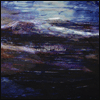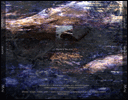MYSTERY SEA 29 | spiracle | [ananta]
![]() ARTWORK
ARTWORK ![]()
![]() INTRODUCTORY
WORDS
INTRODUCTORY
WORDS ![]()
-"
Riding on currents of the atmosphere.
Collecting the radiance of infinite stars.
And listening closely...
To the subtle howling of flames,
the genetic suns in the flow of blood.
To the caresses of the membrane of gravity
by your spiral tentacles.
To the wounds being filled with magma,
the splashes becoming the Milky Way
in the flesh of the sky.
To your blink-of-an-eye,
each a scale of Ananta,
each a lifetime of omnipresent stars."
- Hitoshi Kojo, January 2006
![]() PRESS RELEASE
PRESS RELEASE
![]()
Hitoshi
Kojo (b. 1969, Japan) has worked in various artistic branches
such as music, painting, installation & performance, using both
a traditional & contemporary methodology...
Brought up with the influence of ancient asian culture, he exposed himself
recently to Europe where he currently has most of his activities, absorbing
old myths & customs, & collaborating with other like-minded
artists
(mnortham [under the KODAMA moniker], John Grzinich, Nobu Kasahara,
Loren Chasse to name but a few...). The theme of his projects often
drifts from scanning daily matters, trying to catch that elusive spark
at the very core of a momentum...
Hitoshi Kojo manages also his own label : OCTPIA, since
2000...
Several of his titles were created under the "spiracle"
name, his main solo project)...
-
For Mystery Sea, spiracle has weaved an original/special
mix of a new piece entitled "ananta"...
Listening to "ananta" is like inhaling a
cloud of stars at twilight, drinking up all its creeping flow of energy...
breathing like a snake undulating under the dark primal waves... channelling
unknown forces...
"ananta" is being within the stream, living
it from the inside, becoming it, reaching that impossible oneness, if
only in the phosphorescence of a unique moment...
"ananta" is a key to universal empathy...
a bridge to a world waiting hidden, there behind the curtain...
a deep essential vibe captured just for you...
![]() TRACKS
TRACKS ![]()
01. ananta (Mystery Sea mix)
![]() LENGTH
LENGTH ![]()
62'22
![]() REVIEWS
REVIEWS ![]()
VITAL WEEKLY 513|Frans
De Waard
Hitoshi Kojo is the
man behind Spiracle, although you may know him as Kodama,
his collaboration with MNortham, or his work with John Grzinich and
Loren Chasse. Or perhaps his label Octpia? To me this is all new, but
his work for Mystery Sea is quite nice. It starts out with a forceful
set of organ like sounds, and over the course of this piece, which lasts
over an hour, sea like sounds wash in and out, whereas the organ sounds
are pulled apart and start to modulate. Maybe I have had the volume
more cranked up on this one, but it seemed to me a very 'present' release,
unlike some other releases on this label (or in the genre of drone music
as such), things don't drop back in a level of inaudibility. Having
said that, things aren't very noise either, just present throughout
this piece. One could wonder if things aren't say ten to fifteen minutes
too long, but otherwise this is a pretty strong release, another one
in the mighty Mystery Sea catalogue, and one that, with all it's washy
sounds, fits the label's concept very clear.
vital weekly
TOUCHING
EXTREMES |Massimo
Ricci
The work of Japanese Hitoshi Kojo spreads
its wings over various artistic fields: he creates sounds, paints and
prepares installations, his curriculum vitae finding him in collaboration
with people like Michael Northam, John Grzinich and Loren Chasse. Spiracle
is Kojo's main project; under this alias he gave Mystery
Sea a "special mix" of this recent composition of his, which
is quite a bit different compared to the usual canon of the Belgian
label. "Ananta" is a long, dirty mantra,
centred around a single "tonality" - we never move from there.
The sources are left undefined; the wall of sound has an imposing presence,
even if the basic drone is gradually covered with the soil of interference
(and by processed shortwaves, one would believe), never letting us completely
penetrate its depth. It takes only a few minutes to get used to this
strong presence, as the piece drifts without problems for more than
a hour, during which our mind gives signs of appreciation, especially
at a consistent playback volume - a move that will near "Ananta"
to some of the most consonant (???) releases by David Jackman/Organum.
touching
extremes
CHAIN
D.L.K.|Eugenio Maggi
Rated :
3.5 stars out of 5
Japanese multimedia artist Hitoshi
Kojo, who has recently moved to Switzerland, has collaborated with artists
like mnortham (as Kodama), jgrznich and Loren Chasse, besides running
his own label Octpia and actively collaborating with the remarkable
Cloudmirror project. With this very label he released one of my favourite
pieces of 2005, "Iris", which was a powerful beast of a drone
(see archive). "Ananta" is a 62-minute single piece, and,
while not as mind bending, clearly shows how Hitoshi is able to build
massive soundscapes out of a limited number of layers. I don't know
which sources lie at the basis of the work, but the high-end tones remind
those of a gigantic organ, much like a grittier version of his fellow
Grzinich's pieces. 62 minutes of it could be a bit overwhelming if you're
not in the right mood to go through it and emptying your mind along
the way, but a disciplined listen will surely reward you with a small
scale ecstasy.
chaindlk
MOUVEMENT
NOUVEAU|Tobias
Fischer
Even though Händel’s „Water
Music“ was written almost 300 years ago, it has remained immensely
popular until this very day. Apart from the fact that its melodic motives
are among the most accessible and uplifting in the entire Classical
repertoire, its relation to water, one of the fundamental elements of
human existence, surely must have played a part in this. Maybe in 300
years from now, listeners will treat the output of the Mystery Sea label
with similar love and respect. And “Ananta”
could then well be regarded as one of its archetypal movements.
For most of the time, Mystery Sea releases seem to dwell underneath
the aquatic surface, hiding in their comfortable, dark mould in the
remote corners of the Mariana Trench. “Ananta”
is different. It consists of one single cluster of pan-spectral tonalities,
which gently ondulates and changes its barycentre in slow-motion, but
never moves from there. Even though the bass frequencies rumble menacingly
and get the upper hand in the middle part of the piece, when it appears
to be ebbing off into silence, it is the brightly shimmering upper harmonics,
which have the strongest physical effect, drifting on the music’s
skin like a glistening and glowing light beam. This majestic, supranatural
and flickering aural phenomenon gradually turns into a part of the environmen,
softly embracing the listener like a comforting aurora borealis. On
top of this endless ocean, there is a dose of short wave static, gliding
by effortlessly and dropping water-fall-like into infinity. The result
is disturbing, yet intensely relaxing, just like a vision of a day on
the beach: You’ve got your blanket, a basket with fresh apples
and cheese sandwiches and a copy of “Waiting for Godot”
by your side. What more could you possibly ask for? It
all falls apart of course, once you start asking questions like: “Isn’t
this too long?” or “Shouldn’t something finally happen
now?” or “Where are the drums/melodies/vocals (mark accordingly)?”
So don’t. It is said that Händel composed his “Water
Music” to appease King George I. “Ananta”
could well do the same to your mind. With a little luck, this will be
a Classic in 300 years from now.
mouvement
nouveau
SIGNAL
TO NOISE # 50|Darren
Bergstein
Spiracle presents a single
62-minute work on Ananta that resembles either a forever
blowing gale or a Thomas Köner-like decaying gong in its death-throes.
Other than slight intensity changes in volume, the piece proceeds with
no visible beginning, middle or end. Little happens—electronics
gnaw incessantly, a crushed velvet apocalypse so compressed that, contrary
to the label descriptor, little mystery exists.
signal
to noise

